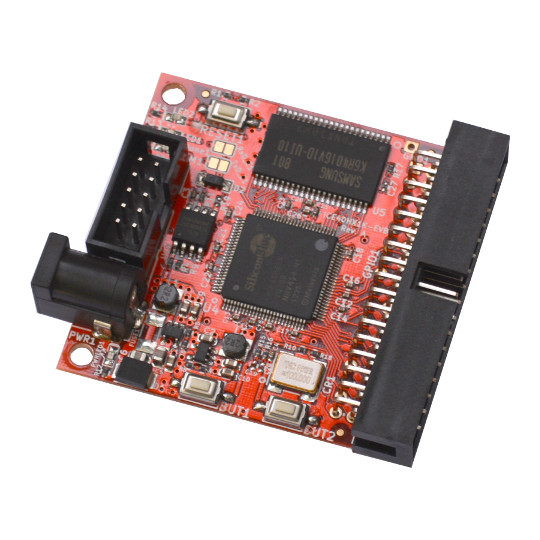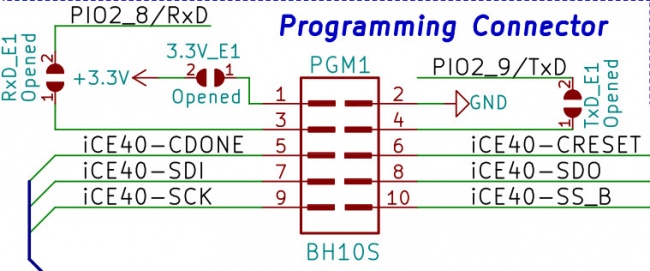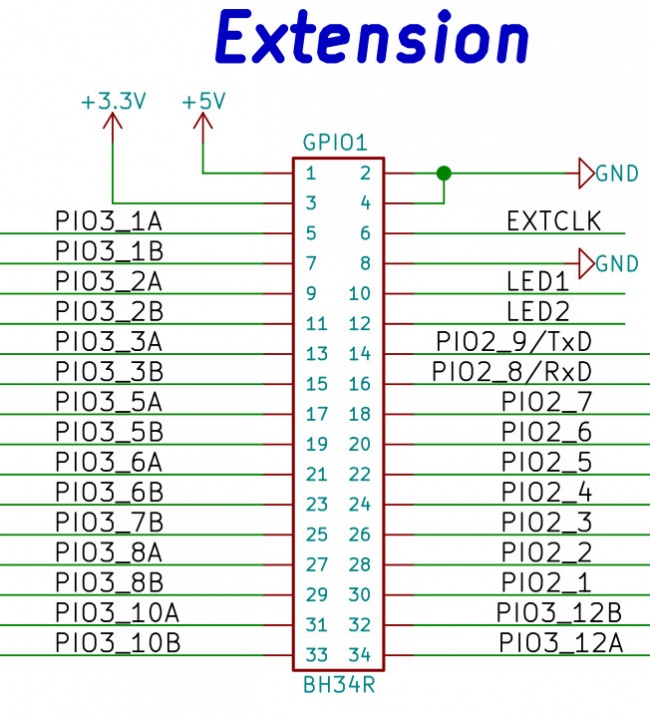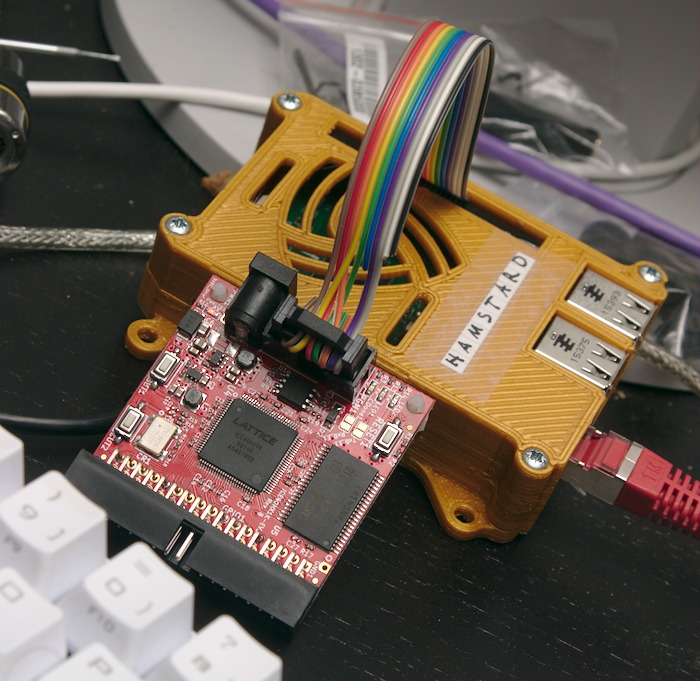Difference between revisions of "ICE40HX1K-EVB"
(→Hardware) |
(→Documents) |
||
| (30 intermediate revisions by 2 users not shown) | |||
| Line 2: | Line 2: | ||
== Documents == | == Documents == | ||
| − | [ | + | [https://www.latticesemi.com/~/media/LatticeSemi/Documents/ProductBrochures/NZ/ProductSelectorGuide.PDF Product Selection Guilde] |
| − | [ | + | [https://www.latticesemi.com/~/media/LatticeSemi/Documents/Handbooks/iCE40FamilyHandbook.pdf iCE40 Family Handbook] |
| − | [ | + | [https://www.latticesemi.com/~/media/LatticeSemi/Documents/DataSheets/iCE/iCE40LPHXFamilyDataSheet.pdf iCE40 datasheet] |
| + | |||
| + | [https://github.com/OLIMEX/iCE40HX1K-EVB/tree/master/gpio1-pcf GPIO headers and TCF] | ||
== Hardware == | == Hardware == | ||
[https://github.com/OLIMEX/iCE40HX1K-EVB GitHub repository with the hardware files] | [https://github.com/OLIMEX/iCE40HX1K-EVB GitHub repository with the hardware files] | ||
| − | iCE40HX1K-EVB programming connector | + | iCE40HX1K-EVB programming connector |
| − | |||
| − | iCE40HX1K-EVB 34-pin bus connector | + | [[File:iCE40PGM.jpg|650px]] |
| − | [[File:iCE40BUS.jpg]] | + | |
| + | iCE40HX1K-EVB 34-pin bus connector | ||
| + | |||
| + | [[File:iCE40BUS.jpg|650px]] | ||
== Software == | == Software == | ||
=== Get started under Linux === | === Get started under Linux === | ||
| + | |||
| + | The hardware requirements to develop for the platform are: | ||
| + | - iCE40HX1K-EVB or iCE40HX8K-EVB | ||
| + | - 3.3V programmer board - OLIMEXINO-32U4 (customers have reported success using other Arduino compatible boards; and also RPi2, RPiB2+, RPi3, RPiB3+ - we have no first-hand experience with anything else than OLIMEXINNO-32U4) | ||
| + | - IDC10-15cm cable to connect iCE40HX1K-EVB with OLIMEXINO-32U4 | ||
| + | - SY0605E 5V power supply adapter | ||
| + | - USB-MINI cable | ||
| + | - optional but recommended USB-ISO | ||
| + | |||
| + | ====Installing Icestorm FOSS tools for iCE40==== | ||
| + | |||
| + | |||
| + | First we need to install the tools necessary to build Icestorm: | ||
| + | |||
| + | sudo apt-get install build-essential clang bison flex libreadline-dev \ | ||
| + | gawk tcl-dev libffi-dev git mercurial graphviz \ | ||
| + | xdot pkg-config python python3 libftdi-dev | ||
| + | |||
| + | Installing the IceStorm Tools (icepack, icebox, iceprog, icetime, chip databases): | ||
| + | |||
| + | git clone https://github.com/cliffordwolf/icestorm.git icestorm | ||
| + | cd icestorm | ||
| + | make -j$(nproc) | ||
| + | sudo make install | ||
| + | |||
| + | Installing Arachne-PNR (the place&route tool): | ||
| + | |||
| + | git clone https://github.com/cseed/arachne-pnr.git arachne-pnr | ||
| + | cd arachne-pnr | ||
| + | make -j$(nproc) | ||
| + | sudo make install | ||
| + | |||
| + | Installing Yosys (Verilog synthesis): | ||
| + | |||
| + | git clone https://github.com/cliffordwolf/yosys.git yosys | ||
| + | cd yosys | ||
| + | make -j$(nproc) | ||
| + | sudo make install | ||
| + | |||
| + | The Arachne-PNR build converts the IceStorm text chip databases into the arachne-pnr binary chip databases. Always rebuild Arachne-PNR after updating your IceStorm installation. | ||
| + | |||
| + | Notes for Archlinux: just install icestorm-git, arachne-pnr-git and yosys-git from the Arch User Repository (no need to follow the install instructions above). | ||
| + | |||
| + | You might want to try a new alternative tool instead of arachne-pnr: nextpnr is new place and route tool from the IceStorm-project. It has improved capabilities like GUI to show the connections between cells of FPGA and support for TRISTATE buffer. You might want to check it here: | ||
| + | |||
| + | https://github.com/YosysHQ/nextpnr | ||
| + | |||
| + | ====Preparing OLIMEXINO-32U4 as programmer==== | ||
| + | |||
| + | |||
| + | Download latest [https://www.arduino.cc/en/Main/Software Arduino IDE] we recommend you to use the one from Arduino.cc current revision is 1.6.9. | ||
| + | |||
| + | Copy iceprog.ino sketch from GitHub/iCE40HX1K-EVB/programmer/olimexino-32u4 firmware to examples folder. | ||
| + | |||
| + | Plug the USB cable to OLIMEXINO-32U4 and start the Arduino IDE | ||
| + | |||
| + | cd arduino-1.6.9 | ||
| + | sudo ./arduino | ||
| + | |||
| + | From Tools select 'Arduino Leonardo' as board. | ||
| + | |||
| + | From same menu select the PORT where the board is attached it will be something like: '/dev/ttyACM0 (Arduino Leonardo)' or '/dev/ttyUSB0 (Arduino Leonardo)' | ||
| + | |||
| + | Also install the SPIMemory library version 2.2.0 (formerly known as SPIFlash). Older versions can't be installed via the Arduino Library Manager so you need to do it manually, download the ZIP archive from here: | ||
| + | |||
| + | https://github.com/Marzogh/SPIMemory/releases/tag/v2.2.0 | ||
| + | |||
| + | Load the library in Arduino from Sketch -> Include Library -> Add .ZIP library... | ||
| + | |||
| + | Open the iceprog.ino sketch | ||
| + | |||
| + | Compile and Upload the sketch. | ||
| + | |||
| + | If everything completes without errors now you have your OLIMEXINO-32U4 set as iCE40HX1K-EVB programmer! | ||
| + | |||
| + | ==== Hardware connection between OLIMEXINO-32U4 and iCE40HX1K-EVB==== | ||
| + | |||
| + | It is a pretty straight-forward - use a 10-pin UEXT compatible cable between the two boards (like CABLE-IDC10-15cm). However, also make sure that the switching button of OLIMEXINO-32U4 is set to position 3.3V! | ||
| + | |||
| + | The signals at the PGM1 connector of iCE40HX1K-EVB are at 3.3V DC! If you use a 5V-only board instead of OLIMEXINO-32U4 you need to drive all SPI signals to 3.3V DC externally. Else there might be a short-circuit or the connection would be unsuccessful. | ||
| + | |||
| + | ====Add iceprogduino to IceStorm==== | ||
| + | |||
| + | Copy iceprogduino folder from GitHub [https://github.com/OLIMEX/iCE40HX1K-EVB/tree/master/programmer programmer] to icestorm and build it | ||
| + | |||
| + | cd icestorm/iceprogduino | ||
| + | make clean | ||
| + | make | ||
| + | make install | ||
| + | |||
| + | ====Make LED blink with IceStorm==== | ||
| + | |||
| + | Copy from GitHub ice40hx1k-evb to icestorm/examples then | ||
| + | |||
| + | cd icestorm/examples/ice40hx1k-evb | ||
| + | make | ||
| + | make prog | ||
| + | |||
| + | LED1 and LED2 should start blink which means the code is successfully loaded | ||
| + | |||
| + | ====Iceprog with Raspberry PI==== | ||
| + | |||
| + | This section is contributed by Andreas Seltenreich | ||
| + | |||
| + | [[File:iceprog.jpg]] | ||
| + | |||
| + | If you have a raspberry PI around, you can use the flashrom utility with Linux’ /dev/spidev to program a bitstream to your ICE40HX1K-EVB or iCE40HX8K-EVB. The following table shows the wiring required for the Pi B+ or 2 (the connection is similar for RPi3 and RPi3B+). I used IDC connectors with a rainbow ribbon for convenient wiring (image above). | ||
| + | |||
| + | | Raspi 2/B+ | | ICE40-EVB | | comment | | ||
| + | |------------+----------+-----------+--------------+----------| | ||
| + | | 17 | =3v3= | 1 | =3v3= | | | ||
| + | | 18 | =gpio24= | 6 | =creset= | | | ||
| + | | 19 | =mosi= | 8 | =sdo= | | | ||
| + | | 20 | =gnd= | 2 | =gnd= | | | ||
| + | | 21 | =miso= | 7 | =sdi= | | | ||
| + | | 22 | =gpio25= | 5 | =cdone= | optional | | ||
| + | | 23 | =clk= | 9 | =sck= | | | ||
| + | | 24 | =ce0= | 10 | =#cd = ss_b= | | | ||
| + | | 25 | =gnd= | | | | | ||
| + | | 26 | =ce1= | | | | | ||
| + | |||
| + | |||
| + | enable SPI device on the Pi (needs reboot) | ||
| + | : echo dtparam=spi=on >> /boot/config.txt | ||
| + | |||
| + | |||
| + | build and install flashrom | ||
| + | : git clone https://www.flashrom.org/git/flashrom.git | ||
| + | : cd flashrom | ||
| + | : make CONFIG_ENABLE_LIBPCI_PROGRAMMERS=no CONFIG_ENABLE_LIBUSB0_PROGRAMMERS=no CONFIG_ENABLE_LIBUSB1_PROGRAMMERS=no install | ||
| + | |||
| + | |||
| + | Once you have enabled the SPI interface and once you have installed flashrom you you can use manual commands or check the scripts that easen it up below. | ||
| + | |||
| + | '''Manual operation:''' | ||
| + | |||
| + | claim GPIO24 for sysfs-control | ||
| + | : echo 24 > /sys/class/gpio/export | ||
| + | |||
| + | |||
| + | Pull GPIO24 low to put the ice40 into reset. The cdone-LED on the board should turn off. | ||
| + | : echo out > /sys/class/gpio/gpio24/direction | ||
| + | |||
| + | |||
| + | Read the flash chip at 20MHz (for short cabling) | ||
| + | : flashrom -p linux_spi:dev=/dev/spidev0.0,spispeed=20000 -r dump | ||
| + | |||
| + | |||
| + | Simply swap -r for -w to write the dump back | ||
| + | : flashrom -p linux_spi:dev=/dev/spidev0.0,spispeed=20000 -w dump | ||
| + | |||
| + | |||
| + | As generated bitstreams are smaller than size of the flash chip, you | ||
| + | need to add padding for flashrom to accept them as image. I used the | ||
| + | follwing commands to do that: | ||
| + | : tr '\0' '\377' < /dev/zero | dd bs=2M count=1 of=image | ||
| + | : dd if=my_bitstream conv=notrunc of=image | ||
| + | |||
| + | |||
| + | Deassert creset to let the ice40 read the configuration from the bus: | ||
| + | : echo in > /sys/class/gpio/gpio24/direction | ||
| + | |||
| + | |||
| + | '''Automated scripts:''' | ||
| + | |||
| + | Check Sagar Acharya's repo, he did some testing with RPi3 and RPi3B+ and made scripts that automate the process described above: | ||
| + | |||
| + | https://notabug.org/sagaracharya/swarajya/src/master/hdl_to_hx8k | ||
=== Get started under Windows === | === Get started under Windows === | ||
Latest revision as of 03:53, 5 October 2023
Contents
Documents
Hardware
GitHub repository with the hardware files
iCE40HX1K-EVB programming connector
iCE40HX1K-EVB 34-pin bus connector
Software
Get started under Linux
The hardware requirements to develop for the platform are:
- iCE40HX1K-EVB or iCE40HX8K-EVB - 3.3V programmer board - OLIMEXINO-32U4 (customers have reported success using other Arduino compatible boards; and also RPi2, RPiB2+, RPi3, RPiB3+ - we have no first-hand experience with anything else than OLIMEXINNO-32U4) - IDC10-15cm cable to connect iCE40HX1K-EVB with OLIMEXINO-32U4 - SY0605E 5V power supply adapter - USB-MINI cable - optional but recommended USB-ISO
Installing Icestorm FOSS tools for iCE40
First we need to install the tools necessary to build Icestorm:
sudo apt-get install build-essential clang bison flex libreadline-dev \
gawk tcl-dev libffi-dev git mercurial graphviz \
xdot pkg-config python python3 libftdi-dev
Installing the IceStorm Tools (icepack, icebox, iceprog, icetime, chip databases):
git clone https://github.com/cliffordwolf/icestorm.git icestorm cd icestorm make -j$(nproc) sudo make install
Installing Arachne-PNR (the place&route tool):
git clone https://github.com/cseed/arachne-pnr.git arachne-pnr cd arachne-pnr make -j$(nproc) sudo make install
Installing Yosys (Verilog synthesis):
git clone https://github.com/cliffordwolf/yosys.git yosys cd yosys make -j$(nproc) sudo make install
The Arachne-PNR build converts the IceStorm text chip databases into the arachne-pnr binary chip databases. Always rebuild Arachne-PNR after updating your IceStorm installation.
Notes for Archlinux: just install icestorm-git, arachne-pnr-git and yosys-git from the Arch User Repository (no need to follow the install instructions above).
You might want to try a new alternative tool instead of arachne-pnr: nextpnr is new place and route tool from the IceStorm-project. It has improved capabilities like GUI to show the connections between cells of FPGA and support for TRISTATE buffer. You might want to check it here:
https://github.com/YosysHQ/nextpnr
Preparing OLIMEXINO-32U4 as programmer
Download latest Arduino IDE we recommend you to use the one from Arduino.cc current revision is 1.6.9.
Copy iceprog.ino sketch from GitHub/iCE40HX1K-EVB/programmer/olimexino-32u4 firmware to examples folder.
Plug the USB cable to OLIMEXINO-32U4 and start the Arduino IDE
cd arduino-1.6.9 sudo ./arduino
From Tools select 'Arduino Leonardo' as board.
From same menu select the PORT where the board is attached it will be something like: '/dev/ttyACM0 (Arduino Leonardo)' or '/dev/ttyUSB0 (Arduino Leonardo)'
Also install the SPIMemory library version 2.2.0 (formerly known as SPIFlash). Older versions can't be installed via the Arduino Library Manager so you need to do it manually, download the ZIP archive from here:
https://github.com/Marzogh/SPIMemory/releases/tag/v2.2.0
Load the library in Arduino from Sketch -> Include Library -> Add .ZIP library...
Open the iceprog.ino sketch
Compile and Upload the sketch.
If everything completes without errors now you have your OLIMEXINO-32U4 set as iCE40HX1K-EVB programmer!
Hardware connection between OLIMEXINO-32U4 and iCE40HX1K-EVB
It is a pretty straight-forward - use a 10-pin UEXT compatible cable between the two boards (like CABLE-IDC10-15cm). However, also make sure that the switching button of OLIMEXINO-32U4 is set to position 3.3V!
The signals at the PGM1 connector of iCE40HX1K-EVB are at 3.3V DC! If you use a 5V-only board instead of OLIMEXINO-32U4 you need to drive all SPI signals to 3.3V DC externally. Else there might be a short-circuit or the connection would be unsuccessful.
Add iceprogduino to IceStorm
Copy iceprogduino folder from GitHub programmer to icestorm and build it
cd icestorm/iceprogduino make clean make make install
Make LED blink with IceStorm
Copy from GitHub ice40hx1k-evb to icestorm/examples then
cd icestorm/examples/ice40hx1k-evb make make prog
LED1 and LED2 should start blink which means the code is successfully loaded
Iceprog with Raspberry PI
This section is contributed by Andreas Seltenreich
If you have a raspberry PI around, you can use the flashrom utility with Linux’ /dev/spidev to program a bitstream to your ICE40HX1K-EVB or iCE40HX8K-EVB. The following table shows the wiring required for the Pi B+ or 2 (the connection is similar for RPi3 and RPi3B+). I used IDC connectors with a rainbow ribbon for convenient wiring (image above).
| Raspi 2/B+ | | ICE40-EVB | | comment | |------------+----------+-----------+--------------+----------| | 17 | =3v3= | 1 | =3v3= | | | 18 | =gpio24= | 6 | =creset= | | | 19 | =mosi= | 8 | =sdo= | | | 20 | =gnd= | 2 | =gnd= | | | 21 | =miso= | 7 | =sdi= | | | 22 | =gpio25= | 5 | =cdone= | optional | | 23 | =clk= | 9 | =sck= | | | 24 | =ce0= | 10 | =#cd = ss_b= | | | 25 | =gnd= | | | | | 26 | =ce1= | | | |
enable SPI device on the Pi (needs reboot)
- echo dtparam=spi=on >> /boot/config.txt
build and install flashrom
- git clone https://www.flashrom.org/git/flashrom.git
- cd flashrom
- make CONFIG_ENABLE_LIBPCI_PROGRAMMERS=no CONFIG_ENABLE_LIBUSB0_PROGRAMMERS=no CONFIG_ENABLE_LIBUSB1_PROGRAMMERS=no install
Once you have enabled the SPI interface and once you have installed flashrom you you can use manual commands or check the scripts that easen it up below.
Manual operation:
claim GPIO24 for sysfs-control
- echo 24 > /sys/class/gpio/export
Pull GPIO24 low to put the ice40 into reset. The cdone-LED on the board should turn off.
- echo out > /sys/class/gpio/gpio24/direction
Read the flash chip at 20MHz (for short cabling)
- flashrom -p linux_spi:dev=/dev/spidev0.0,spispeed=20000 -r dump
Simply swap -r for -w to write the dump back
- flashrom -p linux_spi:dev=/dev/spidev0.0,spispeed=20000 -w dump
As generated bitstreams are smaller than size of the flash chip, you
need to add padding for flashrom to accept them as image. I used the
follwing commands to do that:
- tr '\0' '\377' < /dev/zero | dd bs=2M count=1 of=image
- dd if=my_bitstream conv=notrunc of=image
Deassert creset to let the ice40 read the configuration from the bus:
- echo in > /sys/class/gpio/gpio24/direction
Automated scripts:
Check Sagar Acharya's repo, he did some testing with RPi3 and RPi3B+ and made scripts that automate the process described above:
https://notabug.org/sagaracharya/swarajya/src/master/hdl_to_hx8k
Get started under Windows
Projects
Under construction
FAQ
Under construction






